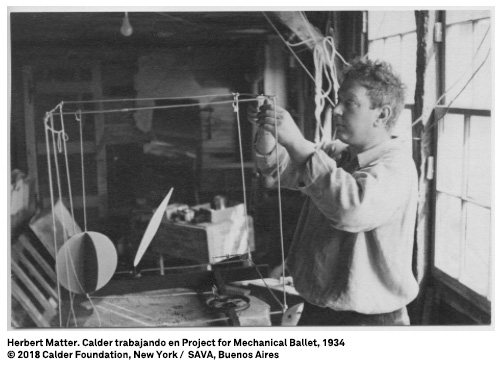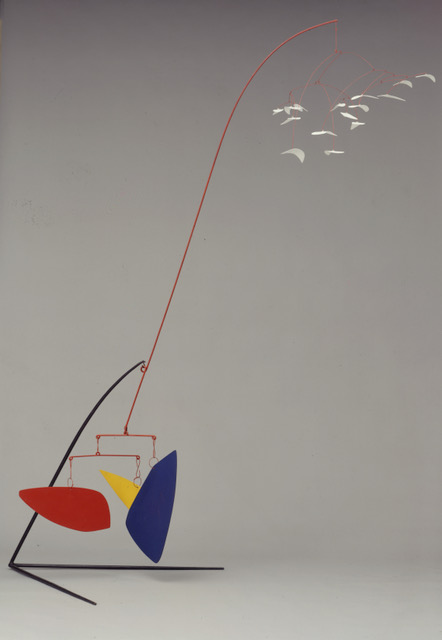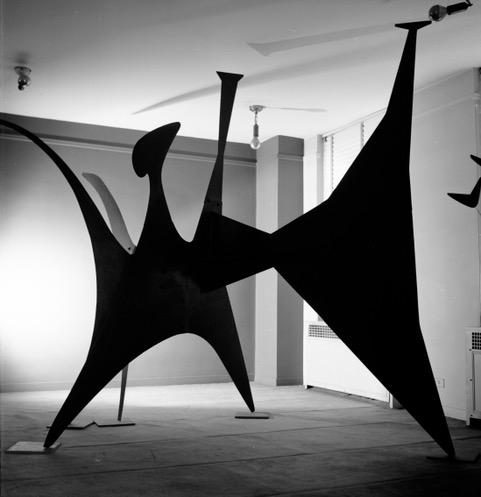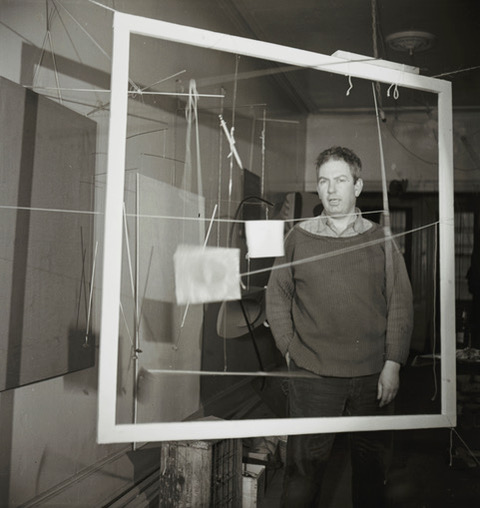
What Abstract Art Means to Me
Alexander Calder
My entrance into the field of abstract art came about as the result of a visit to the studio of Piet Mondrian in Paris in 1930.
I was particularly impressed by some rectangles of color he had tacked on his wall in a pattern after his nature.
I told him I would like to make them oscillate—he objected. I went home and tried to paint abstractly—but in two weeks
I was back again among plastic materials.
I think that at that time and practically ever since, the underlying sense of form in my work has been the system of the Universe, or part thereof. For that is a rather large model to work from.
What I mean is that the idea of detached bodies floating in space, of different sizes and densities, perhaps of different colors and temperatures, and surrounded and interlarded with wisps of gaseous condition, and some at rest, while others move in peculiar manners, seems to me the ideal source of form.
I would have them deployed, some nearer together and some at immense distances.
And great disparity among all the qualities of these bodies, and their motions as well.
A very exciting moment for me was at the planetarium—when the machine was run fast for the purpose of explaining its operation: a planet moved along a straight line, then suddenly made a complete loop of 360° off to one side, and then went off in a straight line in its original direction.
I have chiefly limited myself to the use of black and white as being the most disparate colors. Red is the color most opposed to both of these—and then, finally, the other primaries. The secondary colors and intermediate shades serve only to confuse and muddle the distinctness and clarity.
When I have used spheres and discs, I have intended that they should represent more than what they just are. More or less as the earth is a sphere, but also has some miles of gas about it, volcanoes upon it, and the moon making circles around it, and as the sun is a sphere—but also is a source of intense heat, the effect of which is felt at great distances. A ball of wood or a disc of metal is rather a dull object without this sense of something emanating from it.
When I use two circles of wire intersecting at right angles, this to me is a sphere—and when I use two or more sheets of metal cut into shapes and mounted at angles to each other, I feel that there is a solid form, perhaps concave, perhaps convex, filling in the dihedral angles between them. I do not have a definite idea of what this would be like, I merely sense it and occupy myself with the shapes one actually sees.
Then there is the idea of an object floating—not supported—the use of a very long thread, or a long arm in cantilever as a means of support seems to best approximate this freedom from the earth.
Thus what I produce is not precisely what I have in mind—but a sort of sketch, a man-made approximation.
That others grasp what I have in mind seems unessential, at least as long as they have something else in theirs.
 Alexander Calder The Clangor (Dogwood), 1941 [El estruendo (Cornejo)] Lámina de metal, cable y pintura. © 2018 Calder Foundation, New York / Artists Rights Society (ARS), New York.
Alexander Calder The Clangor (Dogwood), 1941 [El estruendo (Cornejo)] Lámina de metal, cable y pintura. © 2018 Calder Foundation, New York / Artists Rights Society (ARS), New York.
 Ugo Mulas Trois disques, 1967 (Tres discos). Montreal, 1967 Fotografía blanco y negro © Ugo Mulas Heirs. © 2018 Calder Foundation, New York / Artists Rights Society (ARS), New York.
Ugo Mulas Trois disques, 1967 (Tres discos). Montreal, 1967 Fotografía blanco y negro © Ugo Mulas Heirs. © 2018 Calder Foundation, New York / Artists Rights Society (ARS), New York.
Talks with Alexander Calder
por Katharine Kuh
Question: Does your work satirize the modern machin
Calder: No, it doesn’t. That’s funny, because I once intended making a bird that would open its beak, spread its wings and squeak if you turned a crank, but I didn’t because I was slow on the uptake and I found that Klee had done it earlier with his Twittering Machine and probably better than I could. In about 1929, I did make two or three fish bowls with fish that swam when you turned a crank. And then, of course, you know about the Circus. I’ve just made a film of it in France with Carlos Vilardebo.
Question: Which has influenced you more, nature or modern machinery?
Calder: Nature. I haven’t really touched machinery except for a few elementary mechanisms like levers and balances. You see nature and then you try to emulate it. But, of course, when I met Mondrian I went home and tried to paint. The basis of everything for me is the universe. The simplest forms in the universe are the sphere and the circle. I represent them by disks and then I vary them.
My whole theory about art is the disparity that exists between form, masses and movement. Even my triangles are spheres, but they are spheres of a different shape.
Question: How do you get that subtle balance in your work?
Calder: You put a disk here and then you put another disk that is a triangle at the other end and then you balance them on your finger and keep on adding. I don’t use rectangles––they stop. You can use them; I have at times but only when I want to block, to constipate movement.
Question: Is it true that Marcel Duchamp invented the name “mobile” for your work?
Calder: Yes, Duchamp named the mobiles and Arp the stabiles. Arp said, “What did you call those things you exhibited last year? Stabiles?”
Question: Were the mobiles influenced by your Circus?
Calder: I don’t think the Circus was really important in the making of the mobiles. In 1926 I met a Yugoslav in Paris and he said that if I could make mechanical toys I could make a living, so I went home and thought about it awhile and made some toys, but by the time I got them finished my Yugoslav had disappeared. I always loved the circus––I used to go in New York when I worked on the Police Gazette. I got a pass and went every day for two weeks, so I decided to make a circus just for the fun of it.
Question: How did the mobiles start?
Calder: The mobiles started when I went to see Mondrian. I was impressed by several colored rectangles he had on the wall. Shortly after that I made some mobiles; Mondrian claimed his paintings were faster than my mobiles.
Question: What role does color play in your sculpture?
Calder: Well, it’s really secondary. I want things to be differentiated. Black and white are first––then red is next––and then I get sort of vague. It’s really just for differentiation, but I love red so much that I almost want to paint everything red. I often wish that I’d been a fauve in 1905.
Question: Do you think that your early training as an engineer has affected your work?
Calder: It’s made things simple for me that seem to confound other people, like the mechanics of the mobiles. I know this, because I’ve had contact with one or two engineers who understood my methods. I don’t think the engineering really has much to do with my work; it’s merely the means of attaining an aesthetic end.
Question: How do you feel about your imitators?
Calder: They nauseate me.
Question: Do you make preliminary sketches?
Calder: I’ve made so many mobiles that I pretty well know what I want to do, at least where the smaller ones are concerned, but when I’m seeking a new form, then I draw and make little models out of sheet metal. Actually the one at Idlewild (in the International Arrival Building) is forty-‐five feet long and was made from a model only seventeen inches long. For the very big ones I don’t have machinery large enough, so I go to a shop and become the workman’s helper.
Question: How do you feel about commissions?
Calder: They give me a chance to undertake something of considerable size. I don’t mind planning a work for a given place. I find that everything I do, if it is made for a particular spot, is more successful. A little thing, like this one on the table, is made for a spot on a table.
Question: Do you prefer making the large ones?
Calder: Yes––it’s more exhilarating––and then one can think he’s a big shot.
Question: How do your mobiles differ from your stabiles in intention?
Calder: Well, the mobile has actual movement in itself, while the stabile is back at the old painting idea of implied movement. You have to walk around a stabile or through it––a mobile dances in front of you. You can walk through my stabile in the Basel museum. It’s a bunch of triangles leaning against each other with several large arches flying from the mass of triangles.
Question: Why walk through it?
Calder: Just for fun. I’d like people to climb over it but it isn’t big enough. I’ve never been to the Statue of Liberty but I understand it’s quite wonderful to go into it, to walk through.
Question: Léger once called you a realist. How do you feel about this?
Calder: Yes, I think I am a realist.
Question: Why?
Calder: Because I make what I see. It’s only the problem of seeing it. If you can imagine a thing, conjure it up in space––then you can make it, and tout de suite you’re a realist. The universe is real but you can’t see it. You have to imagine it. Once you imagine it, you can be realistic about reproducing it.
Question: So it’s not the obvious mechanized modern world you’re concerned with?
Calder: Oh, you mean cellophane and all that crap.
Question: How did you begin to use sound in your work?
Calder: It was accidental at first. Then I made a sculpture called Dogwood with three heavy plates that gave off quite a clangor. Here was just another variation. You see, you have weight, form, size, color, motion and then you have noise.
Question: How do you feel about your motorized mobiles?
Calder: The motorized ones are too painful––too many mechanical bugaboos. Even the best are apt to be mechanically repetitious. There’s one thirty feet high in front of Stockholm’s modern museum made after a model of mine. It has four elements, each operating on a separate motor.
Question: How did you happen to make collapsible mobiles?
Calder: When I had the show in Paris during 1946 at Louis Carré’s gallery, the plans called for small sculptures that could be sent by mail. The size limit for things sent that way was 18 x 10 x 2 inches, so I made mobiles that would fold up. Rods, plates, everything was made in two or three pieces and could be taken apart and folded in a little package. I sent drawings along showing how to reassemble the pieces.
Question: You don’t use much glass any more, do you?
Calder: I haven’t used it much lately. A few years ago I took all sorts of colored glass I’d collected and smashed it against the stone wall of the barn. There’s still a mass of glass buried there. In my early mobiles I often used it.
Question: Are there any specific works that you prefer and would like to have reproduced?
Calder: What I like best is the acoustic ceiling in Caracas in the auditorium of the university. It’s made from great panels of plywood–––some thirty feet long––more or less horizontal and tilted to reflect sound. I also like the work I did for UNESCO in Paris and the mobile called Little Blue under Red that belongs to the Fogg. That one develops hypocycloidal and epicycloidal curves. The main problem there was to keep all the parts light enough to work.
Question: Do you consider your work particularly American?
Calder: I got the first impulse for doing things my way in Paris, so I really can’t say.
Question: Have American cities influenced you?
Calder: I like Chicago on the Michigan Avenue Bridge on a cold wintry night. There used to be no color but the traffic lights, occasional red lights among the white lights. I don’t think that looking at American cities has really affected me. We went to India and I made some mobiles there; they look just like the others
Varèse on Calder: Excerpt from a Fictional Interview
por Alexander S.C. Rower
Being a grandson of Alexander Calder and having known some of his illustrious friends (among them, Marcel Duchamp, Joan Miró, James Johnson Sweeney, and Edgard Varèse), I come across occasions in my study of my grandfather’s life and works where I’d like to have details of circumstance clarified. This fictional interview is an attempt to mollify that desire. It is an amalgam of my personal and profesional experience, put into a different kind of framework.
Alexander S.C. Rower When did you first meet Calder?
Edgard Varèse Frederick Kiesler introduced us in the fall of 1930. I visited Calder’s studio, which, at that time, was on the rue de la Colonie, in the treizième arrondissement. Eventually, he made a fantastic wire portrait of me. As it has had numerous interventions and mishandlings over the years, it now looks more like me as an old man instead of representing my vigorous youth . . . a bit like Dorian Gray! [Laughs.] So, from then on, I became a frequent visitor, especially around the time he prepared for his show at Galerie Percier in 1930–31. I liked to watch him work, as his abstract compositions resonated with some of my own, such as Intégrales [1924–25] or Ionisation [1929–31].1
ASCR Your wire portrait, now at the Whitney Museum of American Art, New York, was not the only “portrait” Calder made of you. He also made Musique de Varèse [ca.1931], an abstract stabile that premiered at Percier [1]. It comprises an implied sphere of two wire circles that intersect at right angles, with a piece of shiny, tin plated sheet metal at its center that engages a radiating plane. Two small objects, a white wooden sphere and an ebony cube, project from wires that rise from the light-reflecting sheet metal. Was this one of the compositions that resonated with your music?
EV Yes, it has something of a contrapuntal disparity, much like the organization of my own elements. As I have said before, we actually have three dimensions in music: horizontal, vertical, and dynamic swelling or decreasing. And I added a fourth, sound projection—that feeling that sound leaves us with no hope of being reflected back, a feeling akin to that aroused by beams of light sent forth by a searchlight—for the ear as for the eye, that sense of projection, of a journey into space. Your grandfather understood this. He understood that noise was another whole dimension, and he even said that about his own works.
ASCR True, true. My grandfather also indicated on more than one occasion that the most important thing in a composition was disparity. And he, too, worked in the fourth dimension, realized in sculpture as present-time, active experience. Even before the mobile, his wire sculptures incorporated actual movement. His use of wire brings me to my next question. Would you liken your use of innovative, often pedestrian materials to Calder’s own?
EV When I first met Calder, my credo was “New Ears for New Music and New Music for New Ears.” Everyone was perplexed—not only by my materials but also by the timbre, density, rhythm, texture, approach, and so forth. Pierre Boulez said that the first time he heard Ionisation—featuring thirteen percussionists playing forty instruments, such as anvils, a cowbell, triangles, bongos, a güiro, even a lion’s roar (by way of a cuíca!)—it was like an object coming from Mars. In this sense, my vocabulary was much like Calder’s. He reimagined sculpture with wire, sheet metal, broken bits of glass, gongs, tin cans, and objets trouvés, many of which instigated rather shocking sonorous effects. My music called for new ears, yet Calder’s sculpture called for new eyes and ears. [Laughs.] Even [the journal] Transition missed the mark when, in 1936, it assigned Calder’s work to “The Eye” and mine to “The Ear.” The boundaries are rarely so starkly defined. On another level, one could examine how the namesake of my composition—“ionisation,” this breaking away of electrons from atoms —relates to the “atmospheric conditions”—deployed nuclei, atoms, voids—that Calder spoke about in his sculpture.
ASCR Around 1955, Calder wrote about a “ballet object” he had made in Paris more than twenty years earlier. He called it A Merry Can Ballet [ca. 1932–33] [2]. In his manuscript, he made a drawing of a stick with tin cans hanging from strings, and he wrote, “This was the ‘music’—Varèse liked ballet (but not ‘music’).” What did he mean by that?
EV It is often said that A Merry Can Ballet—the phonetic equivalent of “American ballet,” said with a French accent—referenced my composition of the previous decade, Amériques [1918–21, revised 1927]. Both Calder and I enjoyed puns, as did our friend Duchamp. As far back as the Twenties, I decided to call my music “organized sound” and to call myself, not a musician, but “a worker in rhythms, frequencies, and intensities. Yet the music of Calder’s ballet—this collection of tin cans, this notion of chance—was quite challenging for me to accept. His sculptures, especially Small Sphere and Heavy Sphere [1932 / 33], really sent the whole of the Parisian avant-garde into a conceptual conundrum (cat.p.156). But his sound experiments in structured chance were prophetic. In hindsight, it is clear that Calder’s various compositional exercises had a great impact on the young crowd John Cage, Earle Brown, and the like.
ASCR Calder used sound as an aesthetic médium as early as 1932, beginning with Small Sphere and Heavy Sphere. Do you suppose you inspired him?
EV I remember Calder saying that the sirens in Ionisation were the best notes in my music, although he did not make any such direct references in his compositions. My piece was a percussive ensemble, and, in many ways, so was Small Sphere and Heavy Sphere, with its disconcerting crashes, thuds, and so forth— all part of a real-time orchestration. Even more, it was an open composition, meaning that circumstances awaken the form of gesture. Looking back, I can see that this, too, is the actuality of the art in the “mobiles,” veritable tools to present or perform the necessary non-sequence of surprise and happenstance— the build and release of anticipation, as in the circus or good choreography. And yet the defining actions in his special space-time end up with our perceiving something greater than ourselves . . . something universal.
ASCR In Small Sphere and Heavy Sphere, displacing the large “heavy sphere,” which is made of cast iron, sets the small wooden ball in motion around a seemingly random collection of repurposed objects situated on the floor, which have been organized by the viewer. Clearly, this work was a forerunner not only of chance composition but also of avant-garde music in a broader sense. For one, Calder was asking the viewer to step into the roles of composer and conductor, of a sort. How does this compare to—or serve as a departure from—your experiments around that time?
EV I was never interested in the concept of “intervention”—I was seeking technological means to infallibly deliver the sounds I had in mind. I was confronted with tremendous resistance from the musical academic world, which prevented access to greater electronic tools for research and experimentation. I attempted to found a scientific laboratory in order to solve certain musical problems— for example, the impossibility of infinitely sustaining a pitch. This was in the pre electronic age, of course. I employed the means I had at hand, somewhat akin to Calder’s use of everyday materials and his exploitation of their limits. A bit later in my life, Earle Brown brought together a group of jazz musicians whom I directed with graphic notation in a semi-improvisatory fashion, but this was a dalliance. Charlie Parker sought me out as a composition teacher, but he died just days before our planned first lesson.
 Herbert Matter Calder con el marco para Snake and the Cross (Serpiente y la cruz) (1936) en su taller a la calle en Nueva York, invierno 1936 Fotografía blanco y negro © 2018 Calder Foundation, New York
Herbert Matter Calder con el marco para Snake and the Cross (Serpiente y la cruz) (1936) en su taller a la calle en Nueva York, invierno 1936 Fotografía blanco y negro © 2018 Calder Foundation, New York